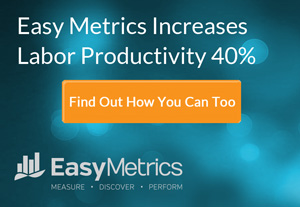Have you ever had the sneaking suspicion that you are losing money on labor for one of your customers? You are not alone. Nearly every labor-intensive facility we’ve analyzed over the last 18 years has had at least one customer whose packaging, distribution process, or customization demands result in financial losses on labor.
In part 1 of this series, I described the need for Activity Based Costing, and how without it, you are flying blind with your customers. Here, we will examine real-world examples of how Activity Based Costing (also called Activity Based Cost Accounting) transforms your visibility on your labor costs.
Too Busy for Big Data?
We’re already years into the Age of Big Data, yet most companies are not using data-driven decision making when it comes to labor costs. With the frenzy of activity in labor-intensive operations, there is little room to breath. Managers are busy trying to make things happen; there is always a new shipment to process, a new fire to put out, or a new customer to manage. C-level execs are looking at the labor big picture, and making decisions and assumptions on broad data categories.
Exposing Your Cost To Serve
When it comes to labor costs, most companies can’t see which customer relationships are profitable, and which customers are losing you money. The solution is to get granular: knowing your “Cost to Serve” by customer, process, and SKU.
So, what exactly is Cost to Serve? It’s finding detailed costs that go far beyond cost of goods and total labor costs. You can reveal your Cost to Serve with activity based costing applied to labor.
Here are some examples of what activity based costing reveals.
Different Packaging: Apples to Apples
Even if the product is identical, like apples, but one customer’s packaging requirements are different from another, huge differences in labor costs are often the result.
Not only is the plastic clamshell packaging itself a more expensive packaging material, but it requires a disproportionate amount of labor when compared to tray packs (standard flat cardboard boxes), or bags. Each apple has to be placed, by hand, one by one, into the clamshell. Then it needs to be snapped down in multiple locations, and in many cases, taped somewhere along the edge.
All this adds up to a lot of labor costs. How do you like them apples? The solution is to face reality and let activity based costing show you exactly how much complicated customer-driven packaging is costing you.
3PL: Massively Different Customer Requirements
The single most dangerous thing a 3PL can do is to offer a flat average pick charge to every customer. Averages are easy to calculate, but financially deadly, because labor costs are double or even triple in certain situations.
Let’s say you are receiving freight, and the container has 5000 cases and 55 SKUs. That container costs twice as much to unload as a container with 1 SKU and 5000 cases.
I’ve seen many containers take 100 labor hours to offload. Imagine 10,000 case containers with 120 different SKUs. Literally, the employee stands in the container and looks at each box and figure out where it goes. It’s like dismantling a rubik’s cube and putting it back together.
Per-case and per-container pricing fails in cases like this, and in less extreme examples. Understanding your costs is the first step in negotiating a structure that works for everybody. Activity based costing for labor in 3PLs is just smart business.
One Small Equipment Swap: Huge Savings
In a distribution environment, there are many equipment choices to do one thing: move stuff. The cost of the equipment isn’t the most important factor, as I’ve seen countless times with clients. Labor is the thing to watch out for with equipment like fork lifts, motorized pallet jacks, and high reach trucks.
Here’s an example. One of our customers recently asked us to give a performance score on each of 4 pieces of equipment used in their picking process. This particular facility was using high reach trucks 80% of time, but we found that the cost to pick was double for high reach truck than the motorized pallet jack.
With one small process change – using a different piece of equipment – they were able to save $115,000 annually. Keep in mind, this was only one little process change, out of dozens of processes in their facility. But one little process adds up when you know your Cost to Serve.
Administrative Work: Insurance Claims
Distribution isn’t the only environment that benefits from activity based costing on labor. Administrative work is equally varied and customized based on customer requirements.
A perfect example of this is the processing of medical claims. Claims management departments deal with wildly variable work, handled by employees who are specially trained to sort out the process. Medicare claims take 3x as long to process as non-medicare claims. Knowing the Cost to Serve on each type of customer, claim and process is the first step in minimizing costs. Companies that are heavy on administrative labor can have better visibility with activity based costing.
State And Local Government: Licensing
We recently helped the Washington State Dept of Licensing better understand their labor costs with activity based costing. The whole state government was under pressure, as the governor ordered to do a large scale cost reduction. They had to identify ways to streamline operations, and decide which offices should be closed. We analyzed roughly 60 field offices, looking at labor costs and process variables.
Each office can do 115 different license types. Some licenses take 5 minutes (like a drivers license renewal), and others take 2 HOURS. By far, the most labor-intensive license was the commercial driver’s license. Out of the 60 offices, some of these spend more time doing the complex licenses, because more truck drivers go there. And other offices in suburbs primarily handle drivers license renewals (easy work).
You can’t measure this in licenses per year, because that would unfairly hold employees accountable for having to do harder, more labor intensive work in an unrealistic time frame.
In this case, activity based costing revealed granular information on licensing labor that allowed the department to justify what they are doing, and how tax dollars are being spent. It’s dangerous to generalize when it comes to government spending. The public doesn’t like it. With activity based costing, state and local governments can get the exact financial picture to make better decisions and communicate their value.
Stay tuned for part 3 of this series when I will detail the steps on how to do activity based costing
……………..
Please share in the comments section below:
-How has your day-to-day busy job prevented you from taking a closer look at labor costs?
-How well has your company dealt with customer profitability?
-What questions do you have about Activity Based Costing? I’ll answer them.
Find out how to Activity Based Costing for your company’s labor with a demo from Easy Metrics.








